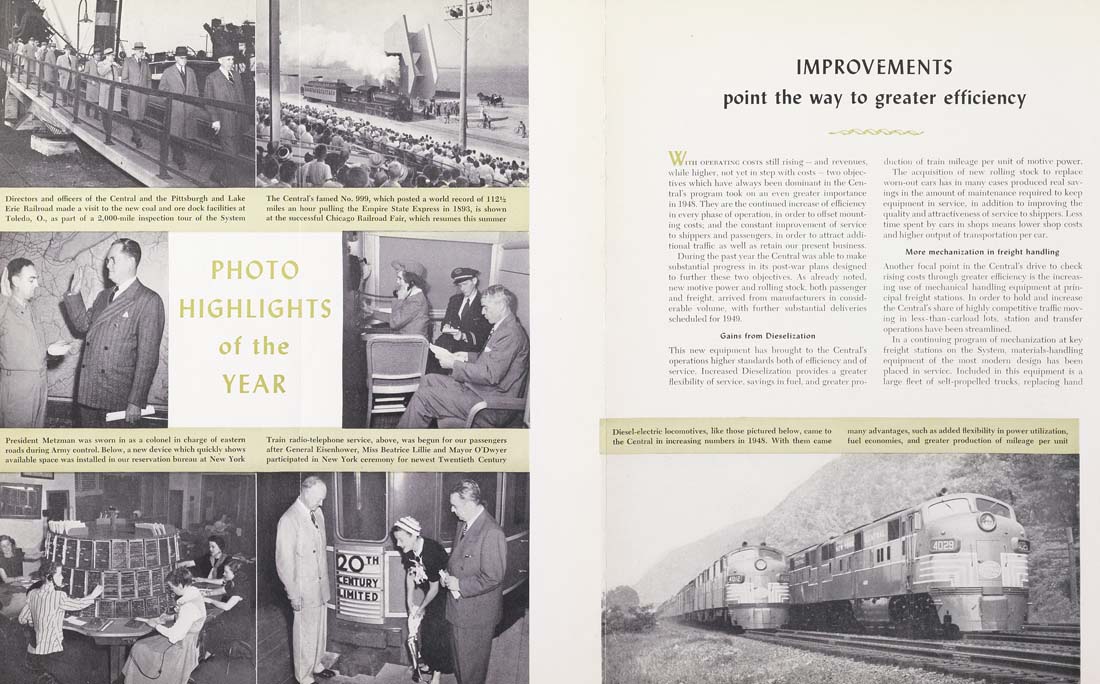IMPROVEMENTS
point the way to greater efficiency
Wx
Directors and officers of the Central and the Pittsburgh and Lake The Central's famed No. 999, which posted a world record of I12>^
Erie K ilro id m kU i visit to the new coal and ore dock facilities at miles an hour pulling the Empire State Express in 1893, is shown
foled ) O IS pill III a i2,ll()()-niilc' inspection tour ol the System at the successfid Chicago Railroad Fair, which resumes this summer
PHOTO
HIGHLIGHTS
of the
YEAR
President Metzman was sworn in as a colonel in charge of eastern
roads during Army control. Below, a new device which quickly shows
available space was installed in our reservation bureau at New York
/iTH OPERATING COSTS Still ri.sing — and revenues,
while higher, not yet in step with costs — two objec¬
tives which have always been dominant in the Cen¬
tral's program took on an even greater importance
in 1948. They are the contiimed increase of efficiency
in every phase of operation, in order to offset mount¬
ing costs; and the constant improvement of service
to shippers and passengers, in order to attract addi¬
tional traflrc as well as retain our present business.
During the past year the Central was able to make
substantial progi-ess in its post-war plans designed
to further these two objectives. As already noted,
new motive power and rolling stock, both passenger
and freight, arrived from manufacturers in consid¬
erable volume, with further substantial deli\"eries
scheduled for 1949.
Gains from Dieselization
This new equipment has brought to the Central's
operations higher standards both of efficiency and of
service. Increased Dieselization provides a greater
flexibility of sen'ice, sa^'ings in fuel, and greater pro¬
duction of train mileage per unit of motive power.
The acquisition of new rolling stock to replace
worn-out cars has in many cases produced real sav¬
ings in the amount of maintenance required to keep
equipment in service, in addition to improving the
quality and attractiveness of service to shippers. Less
time spent by cars in shops means lower shop costs
and higher ontpnt of transportation per car.
More mechanization in freight handling
Another focal point in the Central's drive to check
rising costs through greater efficiency is the increas¬
ing use of mechanical handling equipment at prin¬
cipal freight stations. In order to hold and increase
the Central's share of highlv competitive traffic mov¬
ing in less-tlian-carload lots, station and transfer
operations ha\'e been streamlined.
In a continuing program of mechanization at key
freight stations on the System, materials-handling
equipment of the most modern design has been
placed in service. Inclndcd in this e(|uipmcnt is a
large fleet of self-propelled trucks, replacing hand
Train radio-telephone service, above, was begun for our passengers
after General Eisenhower, Miss Beatrice LiUie and Mayor O'Dwyer
participated in New York ceremony for newest Twentieth Century
Diesel-electric locomotives, like those pictured below, c;
the Central in increasing numbers in 1948, With them
many advantages, such as added flexibility in power utilization,
fuel economies, and greater production of mileage per unit
|








